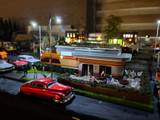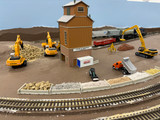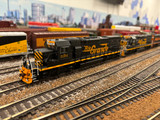Basic Principles of Model Railroad Scenery
Basic Principles of Model Railroad Scenery
Model railroads are not just about trains and tracks; they're miniature worlds that enthusiasts bring to life with intricate details and captivating scenery. Creating realistic and visually appealing model railroad scenery involves understanding a few fundamental principles. In this article, we will delve into these principles and explore how they contribute to crafting a breathtaking miniature landscape.
Scale and Proportion: Getting the Right Look
One of the cornerstones of model railroad scenery is scale and proportion. Scale refers to the size ratio between the model and the real-world object it represents. Maintaining accurate scale ensures that your scenery elements, such as buildings, trees, and people, are in harmony with the trains and tracks. Proportion, on the other hand, involves the relative size of different elements within the scene.
Achieving the right look requires meticulous attention to both scale and proportion. Be sure to research the scale of your model and use appropriate accessories and objects that match it. Creating a scene where everything looks well-proportioned will contribute to a visually pleasing and convincing layout.
Depth and Perspective: Creating the Illusion of Space
Creating depth and perspective is a crucial aspect of model railroad scenery that adds a sense of realism and dimensionality to your layout. Without depth, your scene may look flat and lackluster. Incorporating techniques to convey distance and space can transform your layout into a captivating diorama. Imagine a scene where a distant mountain range is created using progressively lighter shades of gray, giving the illusion of depth as they recede into the background. Similarly, positioning smaller scale objects like buildings, trees, and figures near the front of the layout and gradually larger ones towards the rear can trick the eye into perceiving depth. Using puffballs trees near the backdrop with more detailed trees near the front is another way to add to the depth of the layout. Incorporating a curved track disappearing into a tunnel or around a bend can enhance the feeling of distance, while structures like bridges and overpasses can provide overlapping layers, adding complexity to the scene.
Utilize forced perspective by placing larger objects closer to the foreground and smaller objects farther away. Consider using backdrops with fading colors to simulate distant landscapes, enhancing the illusion of depth. Backdrops featuring receding lines, fading colors, and reduced detail can simulate far-off landscapes. Integrating curved tracks and varying the height of elements can also simulate different elevations, adding another layer of realism to your scenery. By mastering these techniques, you can imbue your model railroad with a three-dimensional quality that draws viewers into your meticulously crafted world.
Texture and Detail: Enhancing Realism
Texture and detail play a significant role in making your model railroad scenery come to life. Just like in the real world, surfaces are not perfectly smooth, and objects have intricate details that catch the eye. Incorporating textures and details into your scenery can elevate the realism of your layout.
Experiment with different materials to simulate various textures, such as using realistic grass mats, gravel, and even creating tiny bodies of water with clear resin. Pay attention to small details like adding signs, graffiti, and weathering effects to structures to replicate the effects of time and wear. The more attention you devote to textures and details, the more your layout will mirror reality. Remember if you are modeling trains and buildings from years ago they are unlikely to look brand new with bright unchipped paint, consider doing some weathering techniques to get an accurate look. Tiny accessories like crates, barrels, and park benches contribute to the scene's narrative, while subtle touches like carefully placed figures engaging in everyday activities infuse a dynamic realism. To emulate water bodies, use clear resin, or Woodland Scenics water options, to craft glistening lakes or meandering streams that catch the light. In essence, it's the meticulous attention to these textures and details that makes your model railroad layout a feast for the eyes, inviting viewers to explore every nook and cranny.
Conclusion
Model railroad scenery is an art form that requires a careful balance of scale, proportion, depth, perspective, texture, and detail. Mastering these basic principles will set you on the path to creating a captivating and lifelike miniature world. Whether you're a seasoned model railroad enthusiast or just starting, keeping these principles in mind will guide you toward crafting scenery that delights the eye and sparks the imagination.
Recent Posts
-
Enhancing Your Model Railroad: Adding Spectacular Special Effects
Embarking on the journey of model railroading opens up a world of creativity and craftsmanship, wher
-
All Aboard the Wisdom Express: Life Lessons from Model Railroading
Embarking on the journey of model railroading opens the door to a world where imagination meets prec
-
Capturing History in Miniature: The Art of Prototype Modeling in the Model Railroad World
Prototype modeling in the model railroad world involves creating miniature replicas of real-life tra




